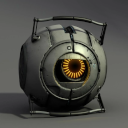Your conscious mind does not experience reality directly.
Your conscious mind does not experience reality directly. There is no path going directly from your eyes to your conscious awareness. Rather, the subconscious collects sensory input. It uses that input to create a virtual simulacrum of the world, a big internal 3D model. That internal 3D representation is what you, the conscious part of your mind, actually interacts with and experiences.
You ever wonder how weird it is that people can have intense, debilitating hallucinations? Like schizophrenics seeing and hearing entirely fictional things. Have you ever seen a camera produce anything like that? A flash of light, a distorted image, dead pixels, etc? Sure, those kinds of errors cameras can produce. But a camera will never display a vivid realistic image of a person that wasn’t ever actually in their field of view.
Yet the human mind is capable of this. In the right circumstances, the human brain is capable of spawning entire fictional people into your conscious awareness. This shows that there is an elaborate subconscious processing layer between what our conscious mind observes and direct sensory input. Your conscious mind is basically experiencing a tiny little internal version of The Matrix, entirely generated on its own wetware. And this subconscious processing layer is what makes hallucinations possible. The processes that produce this internal simulation can become corrupted, and thus allows hallucinations.
This architecture is also what makes dreaming possible. If your conscious mind only perceived things upon direct sensory feedback from the eyes, ears, etc., how would dreaming be possible?
You are essentially experiencing reality through an elaborate 3d modeling version of an AI video generator.
Me and my alters in my system completely agree. They can and have experience reality differently.
I think my AI has a TV problem
The first time I took mushrooms it had been after reading about this kind of thing for about a week.
I recall reading about a man who was effectively blind but his eyes worked fine. What didn’t work fine was the part of his brain that interpreted what his eyes saw. So he just saw smeary streaks of light.
It’s kind of like Linux without its V4L2 system for interpreting video capture devices. It can’t actually see video without it.
That sounds like the story in the Oliver Sacks book, The Man Who Mistook His Wife For a Hat. There was also a story in there about a man who taught himself to see just fine, even though his eyes didn’t work at all. His brain just made educated guesses.
Along those same lines, we’re all blind literally around half the time we’re awake. Our optic processing system can’t keep up with the input as our eyes flit from thing to thing, so we don’t see anything while they move. And they’re moving constantly, even if we’re not aware of it, because only the fovea in the center of the retina has a high enough density of receptors to see details, and also because of sensory fatigue from prolonged static stimulus. In short, we have a tiny field of detailed vision that’s not even working much of the time. That field of vision that feels like a 4K video feed into the mind is a complete lie.
Like the way our subjective experience feels like a continuous, integrated mind fully in control of itself, but in reality, consciousness dips out a couple of times every minute while the brain attends to sensory input.
Even weirder, the conscious mind might not even exist, except as an illusory, emergent phenomenon of sensory experience and memory. There isn’t a place in the brain where it ‘lives’, no part that’s only ever active when we’re conscious.
I think the selective attention test:
further illustrates the limits of human vision and mental processing quite well. Defense attorneys probably ought to play this video in any case where witness testimony is a big component of the prosecution’s case.
California was a state longer than Italy was a nation.
Gulp…“was”?
has been*
Rude.
Can’t be a state if it burns up
Tapsheadmeme.jpeg
There are more trees on earth by far than there are stars in the galaxy.
I had to looks this one up, but missed the “galaxy” vs “universe”. There are an estimated 3 trillion trees, 100-400 billion stars in the milky way galaxy, but potentially 1 septilliom stars in the universe.
However all three of these are estimates, so who actually knows.
I’m not sure where these numbers are from, but my guess is that you mean the Observable Universe, which is just the part of the universe that we can see.
We don’t know how big the full universe is, it could be infinite with an infinite number of stars.
Just some quick Google searches so not sure how reputable, but didn’t feel like copying random links.
But yeah, that’s why I called them out as estimates as I suspect there is a lot of room for error in those numbers.
In my country, which is Morocco, the organ of love isn’t the heart, it’s the liver.
My mom sometimes calls me “lkbida diali” which just translates to “my liver”.
I’m going to flirt with my SO using this now.
Update, they didn’t appreciate my affection :(
Sad.
I tried :(
Not really favourite, but definitely most unbelievable: They elected Donald Trump for president in the US. Twice.
So far!
There won’t be anymore elections so no need to worry about a 3rd time
Butterflies can remember things from their time as a caterpillar.
These memories are retained after going through metamorphosis, the breakdown of their caterpillar form into a cellular soup (or partial soup).
Details here
Printer ink costs more per milliliter than human blood.
“Wow you signed the document in blood, you must be really hardcore.”
“No I’m just cheap.”
California has the same population as Australia.
And over twice the GDP.
I thought california had much more
Doesn’t it have a much bigger population than Aus? Wikipedia says that California has about 39 million people and Australia only 27 million.
That’s even more insane
They may have mixed up the British commonwealth. Canada has a similar population to California
Australia feels like a small country stretched around the perimeter of a genuinely impressive quantity of absolutely nothing.
As an American, I’ll take the Mojave over the Outback any day.
Like a donut with a very spicy hole
The great sand croissant.
A somewhat political fact, but one that made some of my friends dumbfounded:
When a bank issues a loan, it generates that money literally out of thin air and credits that money to the loan account rather than using deposits they already had. For example, if you want to borrow $100,000, the banker approves the loan and doesn’t hand over cash or move existing money around - instead, they just go on their system and credit your account with the sum, that’s it.
While I think your point is true that its much more abstract than people realize. When I worked at a bank and we disbursed loans and credited/debited fees it was from “GLs” (General Ledger?) which were basically just separate accounts to help keep track. Like we had a “member service” one which was for basically anything with good reason. One time someone did a very large amount but he just basically got told to do it a different way.
Its all just in a computer. I could’ve accidentally credited someone a million dollars but it would’ve been realized when I tried to close my drawer and balance everything out. And the branch would have to be balanced at the end of the day so I assume the bank did as well.
On a related note banks take out loans from other banks. I think a lot of people don’t realize that banks have savings accounts so they have money to lend.
As of March 2020 the reserve requirement for banks in the US is 0%.
What the fuck, who changed that? Seems like a horrible idea.
The Fed Board, apparently: https://www.federalreserve.gov/monetarypolicy/reservereq.htm
After reading through that page and the FAQ, I think it’s because the banks should now be compelled to held reserves because Fed pays them a reasonable interest (close to what they would get if they give a very low-risk loan) on them, rather than it being a strict requirement. I don’t know enough about economics to have an opinion on whether it’s a good idea, but I feel like it’s not too horrible? Like, maybe it makes some shitty banks even more susceptible to bank runs, but that’s the reality of fractional reserve banking in general.
Which is why a “run on the Bank” or “Bank run” is unsustainable for Banks these days.
Every eye has a tiny blind spot near the middle. But your brain makes it disappear and you don’t realize it’s there.
You can verify this. Draw a dot on a bit of paper. Close one eye, stare at a fixed point, now move the paper around the center until the dot disappears…magic
What we consider reality, is a synthesis our brain is presenting to us, it is an approximation… realizing that is a real mind blower
I’m going to qualify this—all vertebrate eyes have a blind spot. Cephalopods also have eyes that are like vertebrates (this type of eye is called ‘camera eyes’), but their eye anatomy is such that no blind spot exists for them.
Piggybacking on your fact about the brain effectively editing what we visually perceive, we don’t see our nose (unless you made a concerted effort to look at it) because the brain ignores it.
Also we only see the past since our vision has a bit of “latency”.
So I guess we never see reality but just a delayed representation of our environment as interpreted by our brain.
fun fact: the blind spot is because our optical sensors are installed backwards and that hole is so the optic nerve can pass back through the back of the eye to the brain. some other critters with independently evolved vision systems, such as cephalopods, avoided this particular evolutionary pitfall.
Another fun fact: through that hole there’s also vasculature and capillaries coming through and you can actually see them by looking at a well lit white surface and creating a tiny pinhole with your hand right in front of your eye and wiggling it. Better explained here at around 5:30
That’s awesome, I had no idea, thank you for sharing
What we consider reality, is a synthesis our brain is presenting to us, it is an approximation…
It’s also a coordinated synthesis from all of your input senses (sight, hearing, smell, etc). It also explains why those who have a certain sense stunted (aka blindness, deaf, etc) report having all their other senses heightened. And it’s up to the individual’s brain to assemble those sensory inputs into a complete picture of the world around them, what we dub “reality.” Which then brings into question the nature of common reality, and what defines it. Trippy shot.
Oh I thought my eyes were fucked. I look at a star in my periphery and it’s there, I look at it directly and it’s fucking gone.
So, here’s a lesson from the flight physiology chapter of the private pilot syllabus:
Your vision is a lot worse than you think it is. You probably conceptualize your eye as similar to a digital camera, there’s a lens that focuses light on a sensor made up of an array of light sensitive cells, and that the edge of that array is as densely packed as the center. This is the case for a camera, but not for your eye.
Each of your eyes has over 30 million photoreceptors called rods and cones.
Rod cells come in one variety and are only really good for detecting presence or absence of light. They work well, or can work well, in very dim light, and they form the basis of your night vision. This is why in very dim conditions you might experience your vision in black and white.
Cone cells are less sensitive to light requiring relatively bright light to function, and come in three varieties that respond the strongest to low, middle and high wavelengths of light, what we know as red, green and blue. By comparing the relative intensities of these wavelengths, we can derive color vision. They don’t work well in low light conditions.
The sensor array in the back of your eye that contains these photosensitive cells, called the retina, is sparsely populated toward the edges and doesn’t have very good resolution. Try reading this sentence looking at it through the corner of your eye. It gets denser and denser, and the ratio of cones to rods increases, until you reach a tiny pit in the very center called the fovea.
This is difficult to put into words but unless you’ve been blind since birth you’ll understand what I mean: You use your whole retina to “see.” You use your fovea to “look.” The detailed center of your vision, the spot where you are “looking” is drawn from the fovea through the center of the lens out into the world. When you are looking at something, you are pointing your fovea(s) at it.
There are no rod cells in your fovea, only cones. So you have very high resolution color day vision, but next to no night vision, with your fovea.
This is why things like dim stars in the night sky can be more easily seen with your peripheral vision than your central vision. Your central vision does not have the cells to see well in the dark. It’s not in the anatomy.
We teach this to pilots because distant lights the pilot is using to navigate by, avoiding collisions with obstacles or other aircraft, might be dim enough that the night adjusted eye can’t actually see it with the center vision but can with peripheral vision.
The same chapter teaches about the “hole” through which the optic nerve passes and how that blind spot is capable of hiding something like another airplane from you, which is why you look around and don’t just stare out the windshield. It’s not often a problem because most of the time one eye can see into the other’s blind spot, but it’s useful to know that about your vision.
Each cell will detect some light, undergo a chemical process that fires an adjacent neuron, and then take a very brief moment to reset to be ready to do it again. Each cell is doing this independently, so your eyes don’t have a “frame rate” the way a camera does, but a flickering light begins to look continuous to humans at a rate of about 18 cycles per second and no flicker can be detected somewhere around 40.
Your occipital lobe takes in this choppy inconsistent resolution broken up mess of visual information passed to it via your optic nerves, does some RTX DLSS 4k HDR10 shit to it and outputs the continuous and smooth color 3D picture you consciousness experiences as “vision.”
AND THEN ON TOP OF THAT your brain does optical everything recognition. You can look at millions of different objects - the letters of the alphabet, tools, toys, people, individual people’s faces, leaves, flowers, creatures, stars, planets, moons, your own hands, and recognize what they are with astonishing speed and accuracy.
It’s what scientists call the hellawhack shiznit that happens inside your brizzle.
This isn’t due to the blind spot, but it is still pretty weird to experience! Here’s some more info if you are curious: https://en.m.wikipedia.org/wiki/Averted_vision
Rojava exists.
Consider a dam that is 10m tall
Then consider the height of water behind that dam is 5m tall.
Does the dam need to be built stronger if the water behind it is 1 km long?
How about only 500m?
How about 1m?
The answer is, it doesn’t matter. Water exerts pressure equally regardless of how much water is behind it.
Therefore a graduated cylinder that is 10m tall needs to resist the same amount of force as a dam 10m tall regardless of how much water is behind the dam. Even a thin sliver of water 1mm thick and 5m tall has the same force as a 5m lake behind the dam.
Incompressible fluids are pretty insane
This is also why trees are so fucking crazy to think about. It is impossible to pump water up a hose more than ~32 feet. Like it’s literally physically impossible to stick a pump at the top of a tall building and suck water straight up a pipe. You need a complicated series of pumps and one-way valves to pump it up in stages. Because you’re not really “sucking” the water up the pipe. You’re just lowering the pressure in the pipe, and atmospheric pressure pushes the water upwards to fill the low pressure. After 32 feet tall, the top of the hose/pipe will be a perfect vacuum, atmospheric pressure won’t be able to push liquid water upwards any farther, and the water will just begin cold-boiling in the top of the pipe as the liquid water turns into gas (steam) to fill the vacuum.
But tall trees can move water all the way to their leaves by using only passive capillary action, and suction created by water evaporating out of their leaves. The capillary action is created by tiny straw-like fibers that run all the way up the tree and are bunched together really tightly. Due to surface tension, water is able to “climb” the capillaries as the surface tension fills as much surface area as possible. Then at the top of the tree, as the water evaporates out of the leaves, it draws up fresh water to fill the void.
But that means the bottom of the tree should need to support the pressure of all of the water above it. But it doesn’t, because the surface tension holds the water stable inside of the trunk.
Even crazier fact: it’s not just capillary action drawing water up trees. Trees are actually able to create negative pressure: https://www.science4all.org/article/the-amazing-physics-of-water-in-trees/
Thank you. Your hypothetical question has been a nagging, unresolved background radiation in my mind for decades, but I’d never gotten around to investigating.
Therefore a graduated cylinder that is 10m tall needs to resist the same amount of force as a dam 10m tall regardless of how much water is behind the dam. Even a thin sliver of water 1mm thick and 5m tall has the same force as a 5m lake behind the dam.
Technically only the pressures are equal, and the actual force will be linearly dependent on the area of the dam (or the surface area of the cylinder). That’s why you can make a tall water tank with relatively thin walls, but an actual dam will have to be quite thicc to handle the tensile/compressive stress (depending on the shape of the dam).
That is accounting for static bodies of water, wouldn’t there be force generated in a dynamic situation? Ie the flow of a fast river? Or if the lake is large enough tidal forces? I’m sure it’s negligible levels but still something that must be accounted for?
No, that’s absolutely true. Dynamic loads will need to be accounted for in real world examples.
I’ve seen a few dynamic loads in my day and in my professional opinion I must agree
Another point is that if the dam is 10m tall, it has to be built to withstand 10m of water. just because it sits at 5m most of the time doesn’t mean a heavy rain couldn’t raise the level, and if the dam collapses that’s going to be catastrophic vs just spilling over the top.
Sharks are older than both trees and the north star
Both trees?
Yeah Twin Pines Ma— I mean Lone Pine Mall.
Piney and Sticks
Yes, both of them at the double tree inn obviously
Laurelin and Telperion
Had to look this up- you are indeed correct. The North Star is at most 67 million years old: https://en.m.wikipedia.org/wiki/Polaris
The bluestones in Stonehenge come from West Wales. Instead of quarrying stone from near the monument, they dragged these huge blocks from ~278km away. Likewise, the altar stone comes from ~700km away in North-East Scotland. It must’ve been very important for the ancient Britons to’ve used these specific rocks for some reason, but their religious practices were conveyed via a now extinct oral tradition so no-one knows exactly why they did it.
I thought this got debunked?
Edit: no, it was just the alter (from Scotland!) https://www.bbc.co.uk/news/articles/c207lqdn755o you are correct.
(History Channel Hair Guy)
“MAGNETS”
Consistency of an axiomatic system that contains arithmetic can be proven in this system if and only if it is inconsistent.
k




















